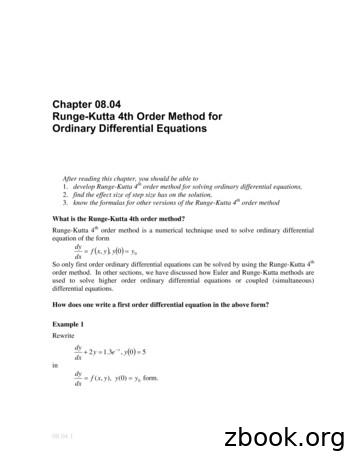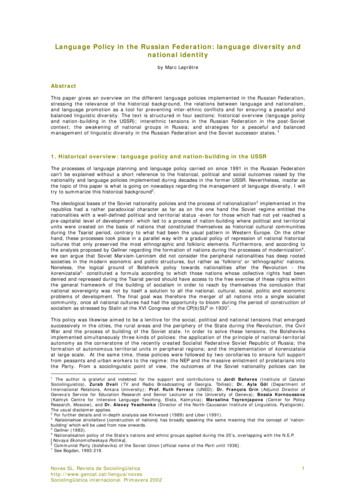Runge-Kutta Methods For Linear Ordinary Differential
NASA-CR-205230rResearchInstitute for AdvancedNASARunge-KuttaMethodsfor Linear Ordinary DifferentialDavidUniversityW. Zinggof Torontoand ToddInstituteRIACS TechnicalT. Chisholmfor AerospaceReport 97.07July eCenter
Runge-KuttaMethodsfor Linear Ordinary DifferentialDavidUniversityW. Zinggof Torontoand ToddInstituteEquationsT. Chisholmfor AerospaceStudiesThe Research Institute for Advanced Computer Science is operated by UniversitiesSpace ResearchAssociation,The American City Building, Suite 2 ! 2, Columbia, MD 21044, (4 !0)730-2656Work reported herein was supported by the National Aeronautics2-13721 to the UniversitiesSpace Research Association(USRA).and Space Administrationunder ContractNAS
LZINGGANDEQUATIONST.T. CHISHOLMAbstractThreenew Runge-Kuttainhomogeneousariseordinaryin thanan governinglinearwavecoefficientsreducesmustuses only two memoryphenomenaare presentedcounterparts,whichrequiretheThismethodis a primaryefficient.is usedAvariable,is an excellentconcern.five and six stages,ofmethods.per dependentThismorenumberfreedomRunge-Kuttathree.are thereforespatialsatisfy.locationsif memoryandfor use with high-orderusesof linearSuchconventionalmethodof Kuttaof linearconventional(ODEs)ODEswhichfourth-orderand sixth-orderfor numericalof the Runge-Kuttais presentedfor simulationstheto linearwhichclassicalequationsofthe coefficientsto developwhilesolutionrestrictionwhichare methodsIn nsnumericalintegrationof largelinearinhomogenoussystemsof ordinaryin the formdudtwhereA is an M by M matrixvectorspartialspatialof lengthM. zationExamplesof suchMaxwellequationsand the spatialtermwhosesuchPDEsasare thegoverningdiscretization.or the boundaryaconditions. Au - earEuleron ( 1)arisewaveu nor t, andin TheinhomogeneoustermIn the contextof pplicationfinite-elementacousticwiththeandtheon the PDEeithersystemof amethod.wavesof A dependis associatedpropagation,u anda sourceof ODEsis
oftenmildly stiff with theeigenvaluesof A typically lying nearthe imaginaryaxis.The systemof ODEs arising from the applicationof a spatial discretizationto a systemofPDEs can be very large, especially in three-dimensionalsimulations. Consequently, theconstraintson the methodsusedfor integratingthesesystemsaresomewhatdifferent from thosewhich have driven much of the developmentof numericalmethodsfor initial value problems.Due to their high accuracyand modestmemory requirements,explicit Runge-Kuttamethodshavebecomepopular for simulationsof wavephenomena[5,6,7,15,17]. Third- andfourth-ordermethodsrequiring only two memory locationsper dependentvariable are particularly useful[3,13,14]. This property is easily achievedby a third-order Runge-Kuttamethod[14], but anadditional stage is required for a fourth-order method [3]. Since the primary cost of theintegration is in the evaluation of the derivative function, and each stagerequiresa functionevaluation,the additional stagerepresentsa significantincreasein expense.For the samereason,error checkingis generallynot performedwhensolvingvery large systemsof ODEsarising fromthediscretizationof PDEs.Therehavebeenseveralattemptsto developefficient methodsfor integratinglinear systemsof ODEs[4,9,10,11]. The basicpremiseof thesemethodsis that the majorcostin evaluatingthederivativefunction is in forming the matrix A and the vector g(t). In the eof linearthe r linearA is neversystemsexplicitlyformedare not appropriateorfor thisapplication.It is wellexceedingandp [1,2].sixth-orderrequiredoura Runge-KuttaFor p 4, methodsmethodsapplicationrequireauthorsthe a reducedsatisfied.of highwas proposedorderat leastRunge-Kuttavariousof high-orderp stageshasp can be derivedandsevenfor eighth-ordernumberan orderof accuracywith p stages.stages,respectively.accuracyof stages,approximationsRunge-Kuttaof stageset al.for linearpreviouslyto thewiththisHowever,Nine[ 1]. Sincenotfifth-stagesarethe cost forrepresentsa significantmethods.considerednumbersixand elevenproportionalZinggmethodof orderaccuracyis roughlyof higher-orderSeveralwhichthatfor seventh-orderlimitationideaknownhomogeneousby Lorenzmethods.by requiring[16,17][8].2to reduceproposeODEsonlymethodsthe numberShanksthatwith[12] wastheaccuracylowbut second-orderof stagesandable to developconditionsstorageotherwise.berequirementsA similar
In this paper,coefficients.Byhigh-orderorderthemethods.In the nextthe ion,loss of generality,Formwe ion,respectpresenttimeconstantin somemethodWe thenevaluationsthe followingdtp-stagemethod.to nonlinearof an Explicitare moreODEsin the derivativea fourth-orderfunctionduA generalwhichRunge-Kuttaapplicablefor linearby nonlinearitywe presentderivativemethodsspecificallyimposedcan be e classicalmemorywe develop(2)can be writtenask l f (tn, un)i-1ki f (tn cih,un h aijkj)i 2, ."(3),pj lPUn l Un h . bikii 1whereh At is the time step, tn nh, and u n is an approximationLow-StorageWe considerthereremainfirst the case p 4. Withten parameters.be satisfied.FourfurtherconditionsthreeFourth-Orderof thesemustC2 a21c 3 a31 a32c4 a41 a42evenbe metMethodthe constraintsFor fourth-orderariseto u (tn).(4)accuracy,for linearif the a43ODEstherehomogeneousareare hefinalwhichmustODEs.conditionAis
associatedwith non-constantcoefficientsor nonlinearity. Therefore,fourth-order Runge-Kuttamethodsarea two-parameterfamily of whichtheclassicalmethodis a particularchoice.If we restrict our attentionto linear constant-coefficientODEs,the number of conditionsisreducedto seven. Theseare4,bi 1i 14cib i i 2c2a32b31,/2 b4(c2a42c2a32a43b4 c3a43 ) 1/6 1/24(5)4.,bi c2 1/'3i 2,bi c3 1/4i 2b3c2a32 b4(c2a42 c32a43)Thereductionnumberin theof stages.FollowingnumberHowever,we can obtainthe approachused imposesof conditionsof Wraythe followingthreeto be ts,valueonlyof the timeor spectraltwo memoryderivative.methodsA and B, the method1.Initially,2.The termu. is storedk I-"doesnot permitus to constraints:b 2 thesestoragethe requirementb l a41With 1/12 a31(6)a42locationsHenceare requiredthe methodare usedfor the spatialproceedsas follows.f(tn, Un) is evaluatedand storedrequiresdiscretization.in A, and B is empty.in B.for boththe enlocations
3. The quantity un ha 31k l, is calculated4.The quantity5.The term k2 f(tn c2h, un ha 21kl)6.Thetheun ha 21 k I is calculatedcontentsoftwoWitha41 a31, anotherand storedis storedlinearin A.in B.is evaluatedmemoryu n h (a 3jkl a 32k 2), which7.and storedand storedlocationsin B.arelinearlycombinedtoformin B.combinationgivesun h(a41kl a42k2),whichis storedinA.8.The term k3 f[tn c39.Thecontentsofh, un h(a31kl a32k2)]thetwomemoryu, h (anl k l a42k2 a43k3),I0.Withbl a41whichis stored11.The12.The contentsWithsevenparameterspossessis storedanotherlinearconstraintsto satisfylocationsimposedlinearlythe sevenmore than one ragegivenwe havein eq. (5).foundtoformto formAlthoughin B.un j.we areleftthis systemwithmayisc3 0.29441651741, 0.07801567728325,a32 0.21640084013679,b2 a42 0.04708870117112,a43 0.69991725920066,b 3 0.47982272993855,bl a410.39507289160708Five.StageFor the caseand storedrequirement, a31 combinedun h(blkl b2k2 b3k3),is evaluatedare linearlythe only solutionc4 0.82502163765,b4in B.in B.by thea21 c2 0.69631521002413,condition:areun h(aalkl a42k2 a43k3)]of the two memoryadditionallocationsand storedin A.term k4 f[tn c4h,thewhichand b2 a42,is evaluatedp 5,we have,Fifth-Orderin additionMethodto the constraintsgivenin eq. (4),the following
c5Consequently,Theaddingcoefficientsaccuracythe fifth stagemustfor linear a51 a52satisfythe a53has producedfollowingconstant-coefficient a54(7)five additionalelevenconditionsparametersin orderfor a total of fifteen.to producefifth-orderODEs:5,bii 1 15cibi 1/'2i 2c2a32b3 b4(c2a42c2a32a43b4 c3a43 ) b5(c2a52 b5[c2(a42a54c2a32a43a54b5 c3a53 a32a53 ) c3a43a54 c4a54)] 1/61/241/120(8)5bic 2 i 2,bi c3i 21/3 1/4b3c2a32 b4(c2a42 c2a43) bs(c2a52 c32a53 c42a54),bi c4i 2 1/5(b4a42 b3a32 b5a52)cbs[a54(a42Thusappliedminimizing3 (b5a53c2 a43 c2) a53a32c22]a four-parameterin order 1/12to choosethe L2 normfamilya methodof a vectorof solutionsfrom b4a43)c b4a43a32c2is obtained.this family.containing3 b5a54 1/'20 1/60SeveralThe followingthe coefficientsc3differentvaluesof the method:havecriteriabeencanbefoundby
a21 - c 2 0.21,c3 0.43,c 4 0.68,c5 0.85,a32 0.47418546365915,a42 0.13437223603429,a 52 0.26302355344001,b2 0.16574368303091,a 43a53 0.10434139625551, 0.57068167533284,b 3 0.41041645692809,b4a54 0.39377303853165,------0.04092124960122,b5 0.37240141154501b I 0.09235969809721witha31 c3 -a32'a41a51 c5-a52-a53-a54Six-StageWithp 6,the followingcondition c 4-a42-a43Sixth-Order,Methodmust be satisfiedin additionto the constraintsgiveneqs. (4) and (7):C6 a61 a62Therefore,therefor linearremaintwenty-oneconstant-coefficientfreeODEs a63 a64coefficients.produces a65Thethe following(9)requirementsixteenof sixth-orderconditions:6,bi:1i 16Zcibi-"i 2c2a32b1/23 b4(c2a42 b6(c2a62c 2a 32a43 c3a43) c3a63 b5(c2a52 c4a64 c5a65) c3a53 c4a54)1/6b4 b 5 [c 2(a 42 a 54 a 32 a 53 ) c 3a43 a 54] b6[a65(a54c4 a53c3 a52c2) a64(a43c3 a42c2) a63a32c2] 1/24accuracyin
b6[a65[a54(a43c3 a42c2) a53a32c2] a64a43a32c21 bsa54a43a32c2c2a32a43a54a65b6 1/120(10)1/7206.,bi c2i 2 1/3 1/46. bi c3i 2b3c2a32 b4(c2a42 b6(a65c2 c2a43) bs(c2a52 a64c2 a63 c2a53c2 a62c2) c2a54)1/126,bii 2c4(b4a42 1/5 b3a32 (b5a54 b5a52 b6a62)c b6a64)c34 b6a65c3b 6[a65(a 52c2 a 53c a s, c 2) bs[a54(a,2c3 (b5a53 b4a43 b6a63)c31/20 a64(a42c2 a43 c2)2 a43c 2) a53a32 c2 ] b4a43a32 a63ac232c2 ]1/60 6.,bi c5i 2b6(a62 c41/6 a63c bs(a52c4 a64 a53c4c 3 [b6(a65a52 a64a42b6[a65a54(a43thechosennonunique):fromsamethe a65c4) a54c4) b4(a42 c 3 [b 6(a65aUsingc4 a63a53 a64ac2 a42 c2)criterionasfive-parameterc4forthe a43c4) b3a3232) b5(a54a42c4 a53a32)43) b Sa 54a 43] c3 b 6a65a a64a43a32fifth-orderfamilyofsolutionsto1/30 b4a43a32]54c2 ] bsa54a43a32method, c2thefollowingtheabove1/120 1/'360coefficientsconditions(againhavebeenpossibly
a21 c2 0.15,c5 0.75,c3 0.36,c6 0.90,c4 0.57,a32 0.45818181818182,a42 0.09769454545455,a52 0.10861879806510,a62 0.20874226393025,b2 0.24971305394585,a43 0.48766666666667,a53 0.04655817933320,a63 0.12686271445897,b3 0.11278150363005,a54 0.44703799502007,am 0.02734417934727,b 4 0.35718962665957,a65 0.37591957583530,b5 -0.00478351095633,b6 0.24659027402511bl 0.03850905269576witha31 c3-a32,a41a51 c5-a52-a53-a54,a61 c6 - a62 c4-a42-a43,- a63StabilityThestabilityfour conditionscontoursin eq. (5) ensuresas the n ludedifferencingmethod.six-stageof the fifth-method,the increaseaxis.stablein Fig.methodSimilarly,methodfamiliesare selected.andmethodwith pureto the spatialderivativesmethodsis a betterof theimaginaryin partialhas the samefifth-definedare somewhatto compensatechoiceandof the firststabilitycontoursare uniquelyis not sufficientregionsSystemssixth-order1. Satisfactionthe stabilitysixth-orderthe fourth-orderTheare shownthat the new fourth-orderregionsconsiderations.is appliedthe- a65Contoursmethodsof the respectiveTherefore,the imaginarynewRunge-Kuttaandthat of the fourth-orderadditionalof the three- a64contourof the fiveanddo notlargerfor the costthanof theif the time step is limitedsixth-ordermethodseigenvaluesare ningwave
propagationphenomenawith no physical dissipation,in the absenceof boundaryconditions.However, Zingg et al. [17] have demonstratedthat by adding a small amountof numericaldissipationto the ingsuchmethods.Theamountof dissipationrequiredis sufficiently low thatthe overall accuracyof the schemeis notcompromised.The stability contourof the methodsuccessfullyusedin [7] for simulationsof thepropagationandscatteringof electromagneticwavesis identicalto thatof the Fourieranalysisto a linearODEErrorwe can determinehomogeneousODE.the errorsSinceproducedour interestby an integrationis in wavemethodpropagation,whenwe consideraof the formdu-dtwhereAnalysisis a real constant.The it.ouRunge-Kutta(11)methodsdevelopedhere producea solutionin theformun OnUo(12)whereP(Y and p is the numberof stages.Thelocal1- -((i0))k--O " "kamplitude(13)and phaseerrorsare determinedfromasfollowsera Iol- 1(14)tan -1 (allOt)erp wherear and (Yi denoteFigs.In ordershown2 and 3 showto accountthe real and imaginarythe local amplitudefor the numberare for approximatelyto p, the amplitudethe methodproduceserrorof stages,equalshownan increase lcohpartsof t .and phaseerrorsthe errorscomputationalevenproducedare plottedeffort.is I I l/p 1. The figuresin accuracy(15)thoughby the threeversusSincethe timeshowthat eachthe extraworktoh/p.newHencemethods.the errorsstep is thus proportionalincreasein the orderhas beenaccountedoffor.
Hencethe fifth- andsixth-ordermethodscan be moreefficient thanthe fourth-ordermethodif asufficiently accuratespatialdiscretizationis used.An ExampleIn ordernewto demonstratemethodslinearandscalarthe validitythe classicalODE givenandfourth-ordersolutionIX : ,.parameters,below,fromstep sizemethodsolutionTheto a sampletheinhomogeneous(16)RK4L,theerror) -Iobtainedandfourth-orderthe newIx i,methodfifth-orderthe errorat the timea I0,steplinearRK5,the tableindicatedandapproachu(0) thefor timeI.WithRK4,thealso 51.19e-44.061.19e-44.055.11 e-65.061.87e-76.06computationsusingTableI. SampleIIthe new methods.methodThemainas the timeas the classicalODEs.RK4method,of theof accuracyis as accurateranginglow-storagesixth-orderthe orderlargertheseIn the tablestep sizesand the newthe expectedfourth-orderand0.20741391939986i.is designatedmethod,magnitude,that the low-storagefor inhomogeneous 5i,(17)at t 2 are comparedare that the new methodsis reduceda(ep't-eXt)IX- ,at t 2 is -2.60430984499756-classicalto showingof the tablewe useof the errorsmethod,frommethodwe apply ,u ae lat u(O)e 't example,magnitudeIn additionestimatedresultsthe0.4 to 0.05.fourth-orderRK6.Forthe exacttheRunge-Kuttaderivations,isu(t)whenof the abovebydu-dtThe exactcorrectnessorder"
ConclusionsThreeODEsnew ientgoodthenthechoicefor the integrationtimeis limitedtimefifth-thecounterpartsnewstability,less rODEs.Thearesixth-ordernewless memorythanthe low-memoryis aanefficientnewto the nrequiresis limitedis roughlybyof linearThis methodsixth-orderfifth-spatialandstepandfor nonlinearfor use with high-ordersizemethodof the methodshere,stepof the new methods.If thenewthe expensetheirbeen presentedRunge-Kuttain [3].of interestthanIf theis the most han the classicalmethodsof stagessignificantlymethodformoreis a ,Methods,,J.C.TheNon-ExistenceBIT 25 (1985),BUTCHER,Theof ricalAnalysisof NTERSchemes,.W.H.TMENRIGHT,Equations,Z. HARASANDPhys.,Runge-Kuttaforof30 (1978),S. nt114 (1994),F.Q. HU, onstant-CoefficientSystemsofIntegration,J.pp. 129-133.Finite-DifferenceSchemesforLong-Timepp. 265-279.ANDJ.L. MANTHEY,ComputationalAcoustics,Low-Dissipationand Low-DispersionJ. Comp.124 (1996),Phys.,pp. 177-.191.oH. .1995,1996.12of thepublishedof a High-AccuracyInternationalFinite-DifferenceConf.by the Houstonon SpectralJ. of Mathematics,and
8.E.N.LORENZ,Integration,,MonthlyL. ime-DifferencingRev.,99 (1971),the emsin Shootingpp. 644-648.IntegrationValueforof InitialProblems,SIAMof LinearSystems,J. Sci.Comput.,14 (1993),pp.860-871.L.F. ionSolution15 (1986)SHANKS,Sept.13.Cheaperof StructuredSimulation,Non-StiffODEs,20 (1973),p. 17.J. ofComputationalType,NASAandpp. 293-300.Higher-OrderApproximationsof Runge-KuttaTND-2920,1965.J.H. WILLIAMSON,Low-StorageRunge-KuttaSchemes,J. Comp.Phys.,35 rfor AeronauticsZINGG,Phenomena,H. LOMAX,l ralMethods,York,MethodsforJuly forFinite-Differenceof High-OrderBoundaryComputationalandOptimizedTR 96.12,Aspectsand Astronautics,Schemes(unpublished).andwith ForcedLOMAX,WaveAdvancementof High-OrderEquationof theforTimeA PaperConference,of the93-3381,inAmerican1993.High-AccuracyJ. on ScientificComputing,Finite-Difference17 (1996),pp.
4/3"5t3i":2,52.'1.5i//!1/ III10.5I"11///:Iorder1: Stability(.)II-3Figure//tcontours-2for the-10IIi123fourth-order(--),4fifth-order(- - -), andsixth-methods.10 41/10.8I////0.6////0.4/.///0.2I/pClal -I-0.2-0.4-O.f-0.8I-100.050.10.150.2WpFigure2: Amplitudesixth-order(.)errorproducedby themethods.14fourth-order(---),fifth-order(- - -), and
x lO 5O. ythefourth-ordermethods.15(--),fifth-order(- - -), and
RIACSMail Stop T041-5NASA Ames Research CenterMoffett Field, CA 94035
The restriction to linear ODEs with constant coefficients reduces the number of conditions which the coefficients of the Runge-Kutta method must satisfy. This freedom is used to develop methods which are more efficient than conventional Runge-Kutta methods. A fourth-order method is present
Oct 13, 2010 · 08.04.1 Chapter 08.04 Runge-Kutta 4th Order Method for Ordinary Differential Equations . After reading this chapter, you should be able to . 1. develop Runge-Kutta 4th order method for solving ordinary differential equations, 2. find the effect size of step size has on the solution, 3. know the formulas for other vers
A novel adaptive Runge-Kutta controller for nonlinear dynami- cal systems Cite this article as: Kemal Uçak, A novel adaptive Runge-Kutta controller for nonlinear
APPLIED IqU/ 'P.ICAL MA IPI( 5 ELSEVIER Applied Numerical Mathematics 20 (1996) 261-272 The development of Runge-Kutta methods for partial differential equations P.J. van der Houwen cw1
BIT33 (1993). 137-150. CONVERGENCE OF A CLASS OF RUNGE-KUTTA METHODS FOR DIFFERENTIAL-ALGEBRAIC SYSTEMS OF INDEX 2 LAURENT JAY Universit de
Computational Physics Orbital Motion. Outline Fourth Order Runge-Kutta Method Equation of motion in 3 dimensions Projectile Motion Problem Orbit Equations. Second Order Runge-Kutta Diferential Equation Estimate value of y at half-step
Figure 8.15 Comparison Velocity u between Stokes near-field with 0.664115 solution and Blasius solution by Runge-Kutta method at 1 and Re 103. 147 Figure 8.16 The profile velocity u solution of Oseen-Blasius, Blasius solution by Runge-Kutta
fourth-order, fifth-order Runge-Kutta numerical integration algorithm. The outcomes derived for each situation demonstrate that the two new variable time step algorithms are both more accurate and much more efficient than their Runge-Kutta counterpart.
Language Policy in the Russian Federation: language diversity and national identity by Marc Leprêtre Abstract This paper gives an overview on the different language policies implemented in the Russian Federation, stressing the relevance of the historical background, the relations between language and nationalism, and language promotion as a tool for preventing inter-ethnic conflicts and for .























